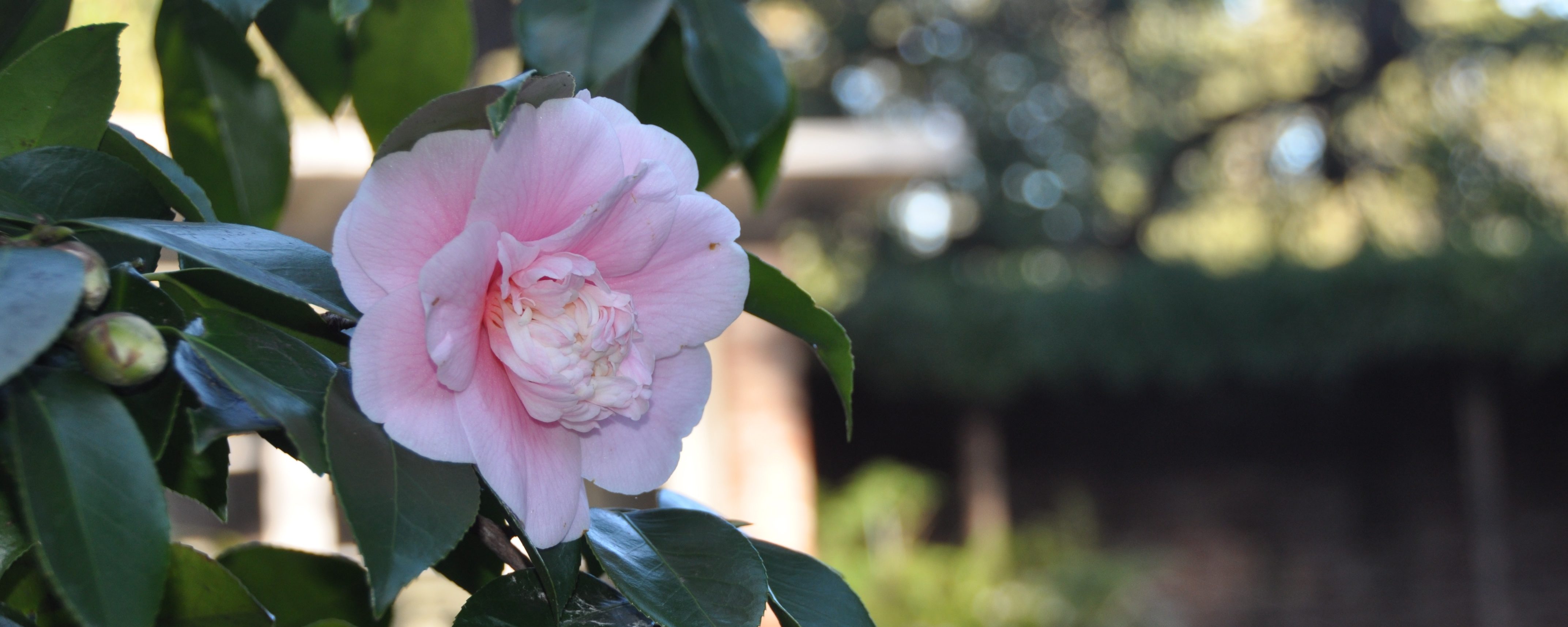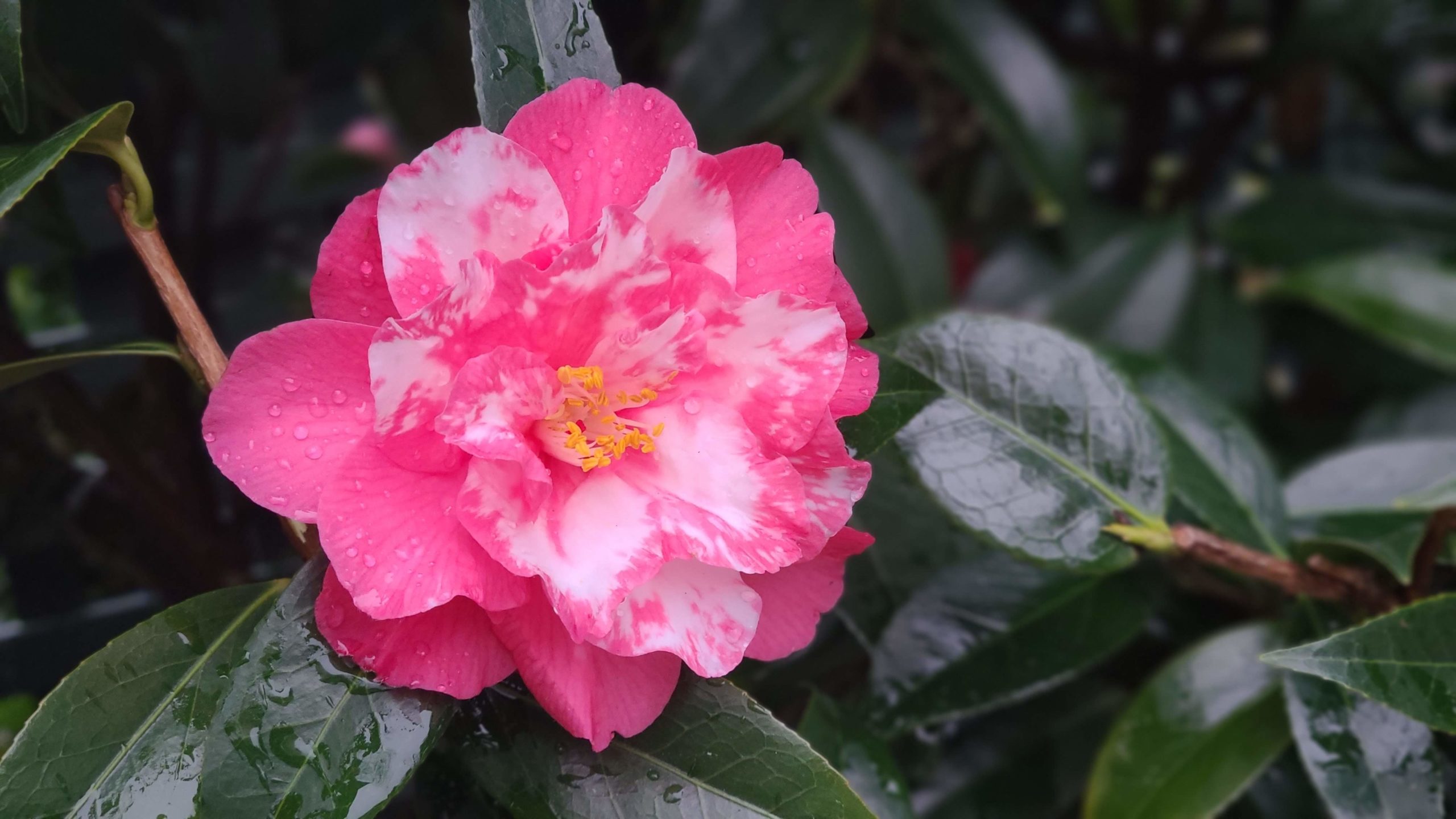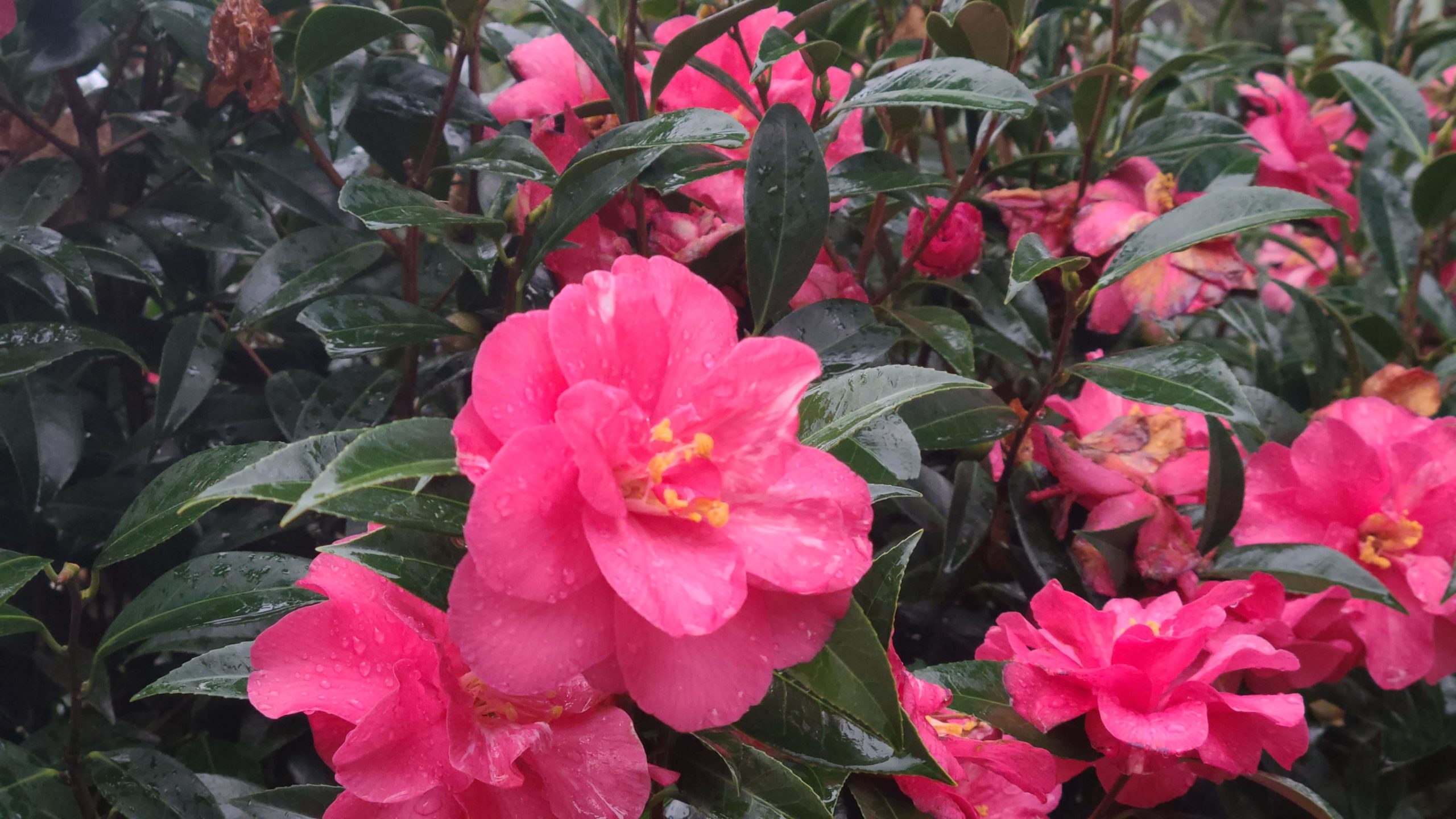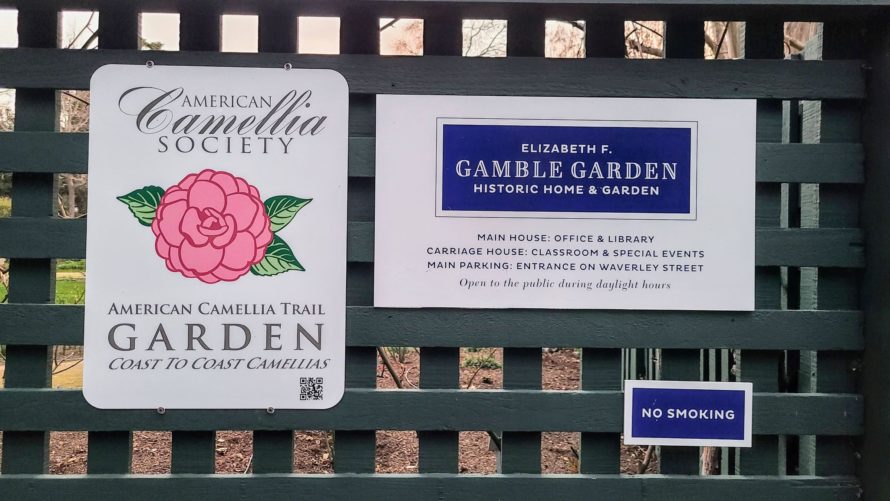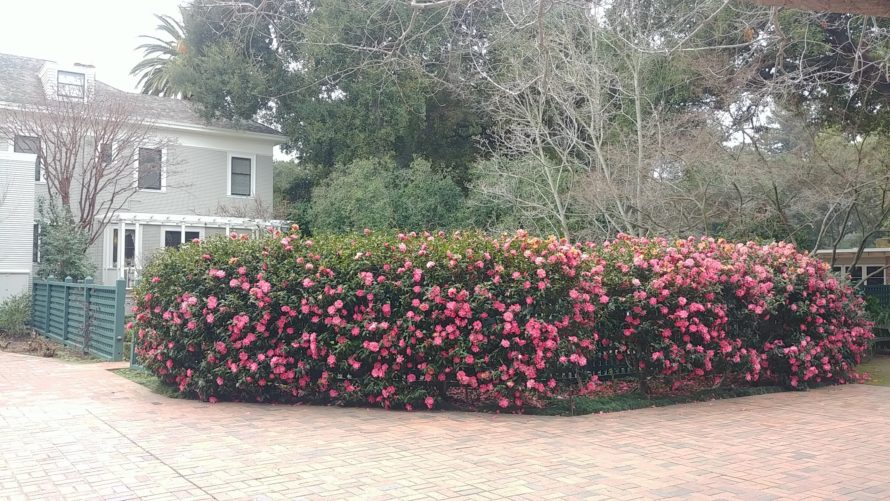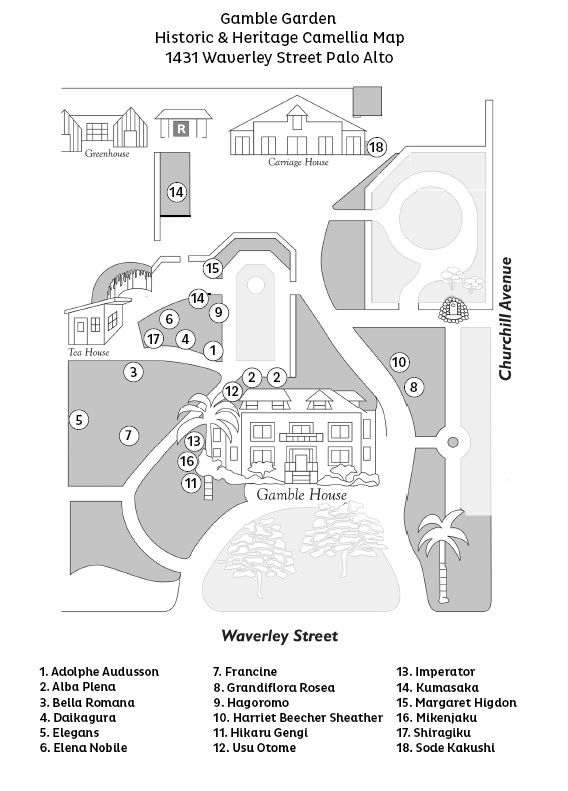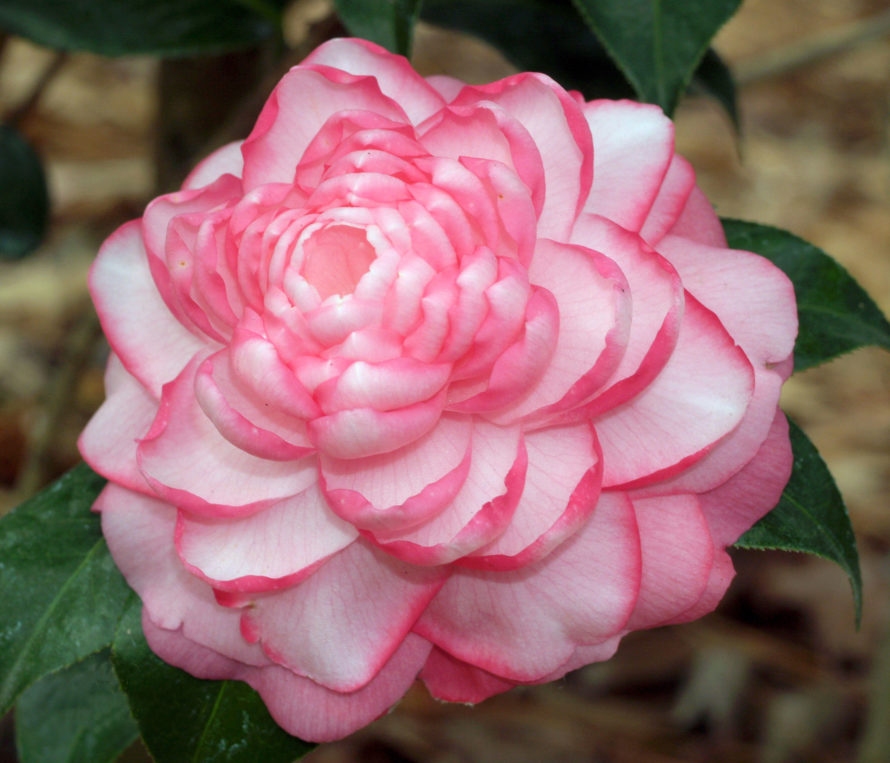Camellia japonica ‘Hikaru Genji’ (Brilliant Genji) 1859.
Purchased by Miss Gamble in 1938 and now in main house bed. It is named for the romantic hero of the early Japanese novel Tale of Genji, a prince renowned for his elegance. It is a medium-sized informal double camellia of dark salmon-pink, bordered in white, streaked with scarlet. Fragrant. Blooms mid-season.
Camellia japonica ‘Kumasaka’ 1695
Purchased by Miss Gamble in 1939. It is one of the oldest camellias in continuous culture, is clearly recorded in Japan in 1695, and was exported to the West in 1896. A medium-sized bloom of deep rose-pink, varies from rose form double to peony form. It blooms mid to late season.
Camellia japonica ‘Shiro Chan’ 1953
Registered by Toichi Domoto, hybridizer, who supplied Miss Gamble with most of her camellias. It is a large to very large camellia and the white coloring is relieved by a basal flush of pink as the blooms open.
Camellia japonica ‘Usu ‘Otome’ (Pink Perfection) 1875
Purchased by Miss Gamble in 1938. It is a sport of the Japanese variety Otome (1828). It is a small formal double of palest-shell pink.
Camellia japonica ‘Shiragiku’ (Purity) 1695
Purchased by Miss Gamble in 1938. It is now planted in front of the Tea House patio. It is a very old formal double variety which can be traced back to 1695 in Japan. It has elegantly fluted white petals, cream at the base. The French synonym is Neige Doree’ which means ‘guilded snow’.
Camellia japonica ‘Daikagura’ (Great Sacred Dance) 1851
Purchased by Miss Gamble in 1942. It is considered one of the greatest camellias of all time. Medium to large in size, peony form, Early blooming, bright pink splotched with white. There is also Beni Daikagura in red, pink, or variegated.
Camellia japonica ‘Grandiflora Rosea’ 1890
Purchased by Miss Gamble in 1944. It is a grand old camellia from the
“naughty nineties). It is mid to late flowering, semi-double of deep pink,
large size and with crinkled petals.
Camellia japonica ‘Elegans’ (Chandleri Elegans Pink) 1831
Purchased by Miss Gamble in 1941. It is a famous camellia from English nurseryman Chandler. It is an elegant, large cultivar of anemone form, and is a deep rose-pink.
Camellia japonica ‘Romany’ (Belgium Red) 1937
Purchased by Miss Gamble in 1941. This may be identical to the olderItalian cultivar Roi Leopold listed in 1855. It is medium in size, formal double, bright red with occasional splashes of white.
Camellia japonica ‘Imperator’ 1908
Purchased by Miss Gamble in 1943. It is a French camellia whose synonym is ‘Big Daddy. It is deep red, large bloom, and full peony form.
Camellia japonica ‘Mikenjaku’ (Nagasaki) 1859
Purchased by Miss Gamble in 1940. It is a Japanese variety named after the city and imported in 1859. It has deep red-pink semi-double blooms, marbled in white.
Camellia japonica ‘Cho Cho San (Madam Butterfly) 1936
Purchased by Miss Gamble in 1941. The blossoms have an extraordinary perfection and delicacy. Like Madam Butterfly, the operatic heroine after which it is named, it is highly vulnerable. It has a medium sized bloom of palest pick and after a short time it drops.
Camellia japonica ‘Hagoromo’ (Feathered Robe) 1695
(syn. Cho No Hagasane) Hagoroma means ‘feathered robe’, and in Japanese folklore is the traditional raiment of an angel. It is blush pink and is considered a heritage plant. Magnoliiflora was long accepted as the European name.
Camellia japonica ‘Alba Plena’ 1792
One of the oldest camellia japonicas in cultivation and one of the first double camellias introduced in the West. ‘Alba Plena’ is recognizable in Chinese manuscripts as far back as the Sung Dynasty (960-1279 A.D.) when it was known as TA PAI (Great White). It is a medium-sized formal double flower of porcelain white and blooms very early.
Camellia japonica ‘Adolphe Audusson’ 1877
Camellia japonica ‘Alba Plena’ 1792
Camellia japonica ‘Bella Romana’ 1863
Camellia japonica ‘Berenice Boddy’ 1946
Camellia japonica ‘C.M. Wilson’ 1949
Camellia japonica ‘Carter’s Sunburst’ 1958
Camellia japonica ‘Chie Tarumoto’ 1977
Camellia japonica ‘Clark Hubbs’ 1960
Camellia japonica ‘Conrad Hilton’
Camellia japonica ‘Covina’
Camellia japonica ‘Dahlohnega’ 1983
Camellia japonica ‘Daikagura’ (Great Sacred Dance) 1851
Camellia japonica ‘Ed Combatalade’
Camellia japonica ‘Elegans’ (Chandleri Elegans Pink) 1831
Camellia japonica ‘Elegans Champagne’ 1975
Camellia japonica ‘Elena Nobile’ 1881
Camellia japonica ‘Eureka
Camellia japonica ‘Finlandia Blush’
Camellia japonica ‘Francine’ 1860 (syn: Chandleri Elegans Pink
variegated, Pride of the Emperor’s Garden).
Camellia japonica ‘Grandiflora Rosea’ 1890
Camellia japonica ‘Grape Soda’
Camellia japonica ‘Guilio Nuccio’ 1956
Camellia japonica ‘Hagoromo’ (Feathered Robe) 1695
(syn. Cho No Hagasane)
Camellia japonica ‘Hana Fuki’ (Flower of Honor) 1930
Camellia japonica ‘Harriet Beecher Sheather’ 1872
Camellia japonica ‘Hikaru Genji’ (Brilliant Genji) 1859
Camellia japonica ‘Holly Bright’ 1985
Camellia japonica ‘Imperator’ 1908
Camellia japonica ‘Kramer’s Supreme’ 1957
Camellia japonica ‘Kumasaka’ 1695
Camellia japonica ‘Margaret Higdon’ 1900
Camellia japonica ‘Mikenjaku’ (Nagasaki) 1859
Camellia japonica ‘Moonlight Bay’ 1982
Camellia japonica ‘Pink Frost’ 1970
Camellia japonica ‘Pink Lace’ (Hishi Karaito) 1875
Camellia japonica ‘Pink Wings’
Camellia japonica ‘Prima Ballerina’
Camellia japonica ‘R.L. Wheeler’ 1949
Camellia japonica ‘Romany’ (Belgium Red) 1937
Camellia japonica ‘Royal Velvet’ 1987
Camellia japonica ‘Shiragiku’ (Purity) 1695
Camellia japonica ‘Shiro Chan’ 1953
Camellia japonica ‘Silver Cloud’
Camellia japonica ‘Sode Kakushi’ (Lotus) 1879
Camellia japonica ‘Usu Otome’ (Pink Perfection) 1875
